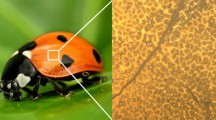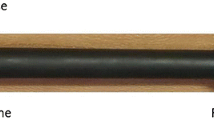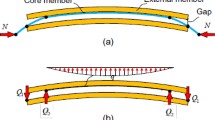Abstract
The barb–barbule structure branching from a feather shaft is a basic unit of a bird feather, and the structure is intricately organized to form the feather vane, which plays an important role in keeping the feather’s integrity during bird flight. In this paper, by coupling nonlinear large deformations of the barb and barbule, an analytical model of delaminating two neighboring barbs on the basis of critical-friction detaching criteria is developed. Considering the rotation and non-rotation of barb–barbule joints in the delamination, a rotatable model (LargeRM) and a non-rotatable model (LargeNRM) are treated to explain the rotation’s contribution to toughening the feather vane. The results show that the predicted interlocking forces of un-detached barbules in the two models were linearly distributed during the delamination. Due to the rotatable barb–barbule joint, the critical detaching force and the elastic strain energy of the two neighboring barbs in the LargeRM are greater than those in the LargeNRM, and this indicates that the rotatable barb–barbule joint could enhance the in-plane delaminating toughness of the feather vane. The present model reveals the nonlinear barb delamination behavior and explains the rotation toughening mechanism of the barb–barbule joint in the barb delamination and further is used to design new bio-inspired interlocking materials, e.g., the feather-inspired Velcro fastener.







Similar content being viewed by others
References
Kovalev, A., et al.: Unzipping bird feathers. J. R. Soc. Interface 11, 20130988 (2014)
Chen, Q., et al.: An analytical hierarchical model explaining the robustness and flaw-tolerance of the interlocking barb-barbule structure of bird feathers. EPL 116(2), 24001 (2016)
Chen, Q., Pugno, N.M.: Bio-mimetic mechanisms of natural hierarchical materials: a review. J. Mech. Behav. Biomed. Mater. 19, 3–33 (2013)
Katti, K.S., et al.: Platelet interlocks are the key to toughness and strength in nacre. J. Mater. Res. 20, 1097–1100 (2005)
Zhang, X., et al.: The beetle elytron plate: a lightweight, high-strength and buffering functional-structural bionic material. Sci. Rep. 7(1), 4440 (2017)
Ennos, A., et al.: Functional morphology of the vanes of the flight feathers of the pigeon Columba livia. J. Exp. Biol. 198(5), 1219–1228 (1995)
Worcester, S.E.: The scaling of the size and stiffness of primary flight feathers. J. Zool. 239(3), 609–624 (1996)
Wang, X., et al.: Size scaling and stiffness of avian primary feathers: implications for the flight of Mesozoic birds. J. Evol. Biol. 25(3), 547–555 (2012)
Purslow, P.P., et al.: Mechanical properties of primary feathers from the pigeon. J. Exp. Biol. 73, 251–260 (1978)
Pennycuick, C.J., Lock, A.: Elastic energy storage in primary feather shafts. J. Exp. Biol. 64, 677–689 (1976)
Lingham-Soliar, T.: Feather structure, biomechanics and biomimetics: the incredible lightness of being. J. Ornithol. 155, 323–336 (2014)
Bonser, R.H.C., Purslow, P.P.: The Young’s modulus of feather keratin. J. Exp. Biol. 198, 1029–1033 (1995)
Wang, B., Meyers, M.A.: Light like a feather: a fibrous natural composite with a shape changing from round to square. Adv. Sci. 4(3), 1600360 (2017)
Macleod, G.D.: Mechanical properties of contour feathers. J. Exp. Biol. 87, 65–71 (1980)
Corning, W.R., Biewener, A.A.: In vivo strains in pigeon flight feather shafts: implications for structural design. J. Exp. Biol. 201, 3057–3065 (1998)
Wang, B., et al.: Seagull feather shaft: correlation between structure and mechanical response. Acta Biomater. 48, 270–288 (2017)
Chen, H., et al.: Biomimetic drag reduction study on herringbone riblets of bird feather. J. Bionic Eng. 10, 341–349 (2013)
Sullivan, T.N., et al.: A lightweight, biological structure with tailored stiffness: The feather vane. Acta Biomater. 41, 27–39 (2016)
Sullivan, T.N., et al.: Reversible attachment with tailored permeability: the feather vane and bioinspired designs. Adv. Fun. Mater. 27(39), 1702954 (2017)
Pugno, N.M.: Velcro® nonlinear mechanics. Appl. Phys. Lett. 90, 121918 (2007)
Chen, Q., et al.: Mechanics of plant fruit hooks. J. R. Soc. Interface 10, 20120913 (2013)
Vokoun, D., et al.: Velcro-like fasteners based on NiTi micro-hook arrays. Smart Mater. Struct. 20, 085027 (2011)
Mariani, L.M., et al.: Observations of stick-slip friction in Velcro®. Tribol. Lett. 56, 189–196 (2014)
Acknowledgements
This work was partially supported by the National Natural Science Foundation of China (NSFC) (Nos. 31300780, 11972118, 11772093, 61821002), the Fundamental Research Funds for the Central Universities (No. 2242016R30014, 2242017K40221), and ARC (FT140101152). NMP is supported by the European Commission with the Graphene Flagship Core 2 n. 785219 (WP14 “Composites”) and FET Proactive “Neurofibres” n. 732344 as well as by the MIUR with the “Departments of Excellence” grant L. 232/2016, ARS01-01384-PROSCAN and PRIN-20177TTP3S.
Author information
Authors and Affiliations
Corresponding author
Additional information
Publisher's Note
Springer Nature remains neutral with regard to jurisdictional claims in published maps and institutional affiliations.
Electronic supplementary material
Below is the link to the electronic supplementary material.
Rights and permissions
About this article
Cite this article
Chen, Q., Pugno, N.M. & Li, Z. The rotation toughening mechanism of barb–barbule joint in the barb delamination of feathers. Acta Mech 231, 1173–1186 (2020). https://doi.org/10.1007/s00707-019-02566-w
Received:
Revised:
Published:
Issue Date:
DOI: https://doi.org/10.1007/s00707-019-02566-w




